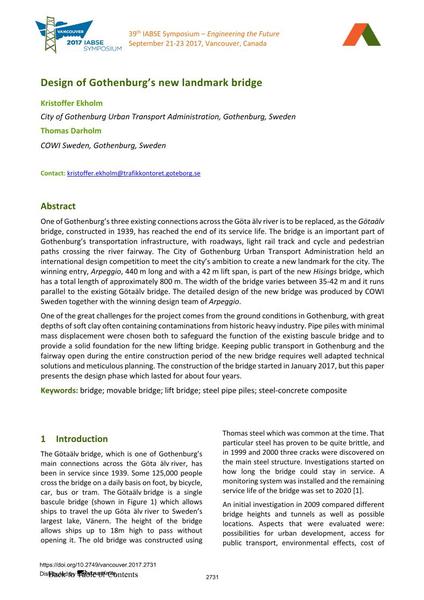Design of Gothenburg’s new landmark bridge

|
|
|||||||||||
Détails bibliographiques
| Auteur(s): |
Kristoffer Ekholm
(City of Gothenburg Urban Transport Administration, Gothenburg, Sweden)
Thomas Darholm (COWI Sweden, Gothenburg, Sweden) |
||||
|---|---|---|---|---|---|
| Médium: | papier de conférence | ||||
| Langue(s): | anglais | ||||
| Conférence: | IABSE Symposium: Engineering the Future, Vancouver, Canada, 21-23 September 2017 | ||||
| Publié dans: | IABSE Symposium Vancouver 2017 | ||||
|
|||||
| Page(s): | 2731-2738 | ||||
| Nombre total de pages (du PDF): | 8 | ||||
| Année: | 2017 | ||||
| DOI: | 10.2749/vancouver.2017.2731 | ||||
| Abstrait: |
One of Gothenburg’s three existing connections across the Göta älv river is to be replaced, as theGötaälvbridge, constructed in 1939, has reached the end of its service life. The bridge is an important part of Gothenburg’s transportation infrastructure, with roadways, light rail track and cycle and pedestrian paths crossing the river fairway. The City of Gothenburg Urban Transport Administration held an international design competition to meet the city’s ambition to create a new landmark for the city. The winning entry,Arpeggio, 440 m long and with a 42 m lift span, is part of the newHisingsbridge, which has a total length of approximately 800 m. The width of the bridge varies between 35-42 m and it runs parallel to the existing Götaälv bridge. The detailed design of the new bridge was produced by COWI Sweden together with the winning design team ofArpeggio. One of the great challenges for the project comes from the ground conditions in Gothenburg, with great depths of soft clay often containing contaminations from historic heavy industry. Pipe piles with minimal mass displacement were chosen both to safeguard the function of the existing bascule bridge and to provide a solid foundation for the new lifting bridge. Keeping public transport in Gothenburg and the fairway open during the entire construction period of the new bridge requires well adapted technical solutions and meticulous planning. The construction of the bridge started in January 2017, but this paper presents the design phase which lasted for about four years. |
||||
| Mots-clé: |
pont pont mobile
|
||||
